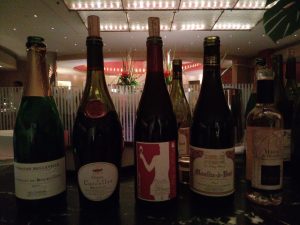
I attended a Patina Restaurant Group wine dinner with a friend one night in November and for those of you who are not familiar with Patina, they manage several restaurants (mainly in the Midtown, New York City area but outside of Manhattan as well), such as La Fonda del Sol, The Sea Grill and Nick and Stef’s Steakhouse, to name a few. I was at Brasserie 8 1/2 that night with a friend who had graciously invited me and the wine region in the spotlight was Beaujolais. This was especially fitting given the fact that it was harvest season and almost time to celebrate Beaujolais Nouveau Day. The occasion typically involves drinking the Beaujolais Nouveau vintage of the current year.
Each fall, in the third week of November to be exact, the new vintage of Beaujolais Nouveau is allowed to ferment for three weeks before it is bottled and shipped to liquor stores around the wine drinking world. In the United States, Beaujolais Nouveau is often served at Thanksgiving partly because the Thanksgiving holiday occurs exactly one week after the release date for Beaujolais Nouveau. Beaujolais Nouveau is a vin de primeur, and is therefore meant to be drunk immediately, or at the very least, within half a year.
The wines are young (as the name suggests) and that is not necessarily a bad thing. Young wines have their qualities as do aged wines. Beaujolais Nouveau is typically fresh, light bodied, fruit driven, bright, and low in tannins, and they can be quite appealing. Carbolic maceration is the fermentation method used in the production of Beaujolais Nouveau. Carbolic maceration involves fermenting the juice while it is inside the grape skin through the addition of carbon dioxide. The conventional fermentation process involves crushing the grapes to release the juice then allowing naturally occurring yeasts to convert the sugar in the grape juice to ethanol. Carbolic maceration results in wines with low tannins and this helps to give Beaujolais Nouveau a light and fresh red fruit and berry flavor profile that makes for easy drinking.
Given the association of Beaujolais Nouveau with the celebration of the harvest and the fact that Beaujolais Nouveau is often the most prevalent type of Beaujolais found in markets outside of France (although the French do drink a lot of Beaujolais Nouveau in honor of the tradition), it is not surprising to find that some wine drinkers believe that Beaujolais Nouveau is the only type of wine made in Beaujolais. Some wine drinkers do not realize that many wines made in the region of Beaujolais are not even “Nouveau” and are not produced using carbolic maceration.
Beaujolais is officially a part of the prestigious French wine region of Bourgogne. Gamay is the principal grape grown in Beaujolais. Gamay is a quality and versatile red grape varietal that can make rich and complex wines. I had the opportunity to try some of what the Beaujolais region has to offer beyond the “Nouveau.”
I had three Beaujolais with dinner that night and they demonstrated the massive potential of the Gamay grape when it comes to producing a quality Beaujolais wine beyond the fresh, fun and fruity Beaujolais Nouveau that some wine drinkers feel lack complexity although they might be enjoyable to drink.
I talked to the Patina Restaurant Group Beverage Director C.J. Jui who collaborated with Chef Franck Deletrain to create the Beaujolais and classic French pairing menu. He mentioned that many people continue to believe that Beaujolais Nouveau is the only type of wine that is produced in Beaujolais. Worst still, some have only had poorly crafted Beaujolais Nouveau and even complained when they received a quality Beaujolais because it tasted nothing like the Beaujolais Nouveau they were familiar with. They did not know what they have been missing.
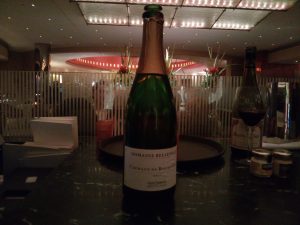
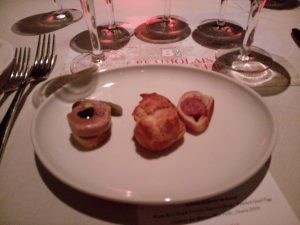
A departure from the Beaujolais centered pairings was a fresh, effervescent and delicately citrus and floral Domaine de Bellville, Crémant de Bourgogne NV. It accompanied a trio of hors d’oeuvres, including a sausage wrapped in brioche, a quail fois gras with black truffle and an airy cheese gougères.

A Domaine Richard Chateau de Corcelles, Brouilly, 2015 was poured with a first course of gratineed pike quenelles in a Nantua style sauce. The fresh raspberry notes, balanced fruit flavors and extended finish of this wine was a perfect accompaniment to this classic dish.
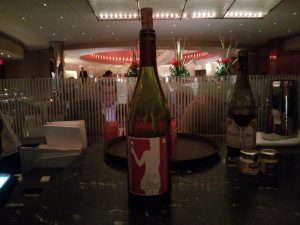
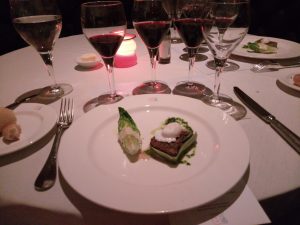
A second course of warm beef shank terrine topped with poached quail egg was complemented by a Château des Moriers, Miss Vicky, Fleurie 2010 with rich notes of ripe strawberry, cherry and licorice. This vintage had the weight and structure to hold up to the concentrated meaty flavors of the beef shank terrine.

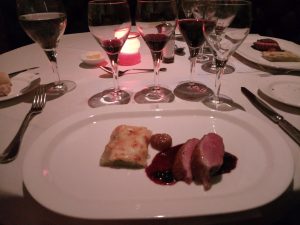
A third course of roasted duck, chestnuts and braised cardoons in a huckleberry sauce was served with a Chateau du Bois de la Salle, Cuvee Le Vieux Bourg, Moulin-a-Vent, 2011 with floral and fragrant red fruit and berry aromas, notes of violet and cherry, and subtle sweet spice. Moulin-a’-Vent are sometimes aged in oak, making them comparably more robust than other Beaujolais. They also have bigger tannins, greater structure and can be aged for up to a decade.
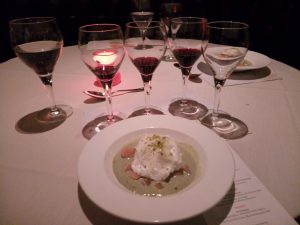

A classic Floating Island of poached quince in a pistachio creme Anglaise paired with a la Prieure de la Veuve, Muscat de Rivesalte, 2009, provided a light, sweet and nutty contrast to the hearty and roasted flavors of the previous course. The Muscat gave off aromas of citrus and tropical fruit along with a mild mint coolness, and a lingering silky finish.

Be First to Comment